Posted by Elena del Valle on April 6, 2016
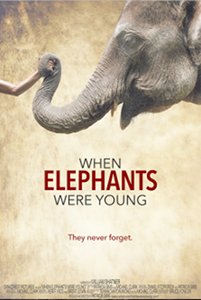
When Elephants Were Young
Photos, video: canazwest pictures
Canadian filmmaker Patricia Sims cares about endangered Asian elephants, a great deal. She and her collaborators dedicated five years to filming elephants and elephant handlers in Thailand at the end of which they produced When Elephants Were Young, an 86-minute documentary narrated by actor William Shatner. The film, in English and Thai with subtitles, will show at 5:30 p.m. April 8 at the Cinemark Palace, 3200 Airport Road, Boca Raton, and 12 noon April 13 at the Parisian 17, 545 Hibiscus St, West Palm Beach, as part of the Palm Beach International Film Festival in Palm Beach County, Florida.Scroll down to watch a trailer of the film.
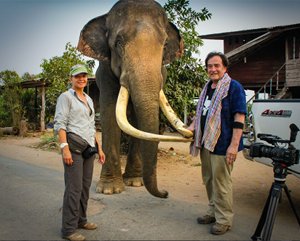
Patricia Sims and Michael Clark dedicated five years to the project
The film follows Wok, a young man, and Nong Mai, his young captive elephant, in their struggle to make a living begging on the streets of Bangkok, Thailand. When the opportunity arises to release Nong Mai to the forest Wok must decide, torn between his affection for the elephant who is also his only source of income, what is best. Can an elephant who has only known a life of captivity survive in the wild? The film zooms into the daily lives of its protagonists, examining the paradoxes of elephants in captivity.
According to Sims, When Elephants Were Young will appear in theaters across North America on World Elephant Day, August 12, 2016. Theater listings should be available in June. Around that same time it should become available globally on various video on demand platforms such as iTunes and Amazon. In Canada, it is slated for broadcast on the CBC Documentary Channel in fall 2016.
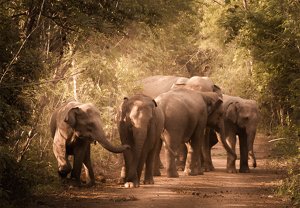
Asian elephants in Thailand from the film When Elephants Were Young
“There were many, many challenges, as is often the case with independent documentary filmmaking!” Sims said by email when asked about the biggest challenge she faced in the making of the film. “For sure, funding was a big challenge, and continues to be so even for this release stage of the film. There are many costs required to release our film, or any film, to the public. Often people are surprised to learn what is involved in the distribution stage for independent film, and what it takes to get a film out to the world.”
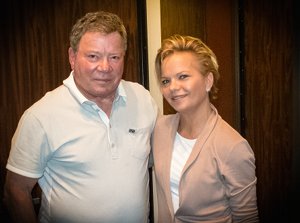
Patricia Sims, director, and William Shatner, narrator, When Elephants Were Young
The film’s budget was under one million dollars. Sims relied on “a combination of self-funding, crowd-funding, and private funding and a lot of in-kind support from many generous people who wanted to help us tell this story, and support the elephant cause.”
When asked about the rewards and surprises along the filmmaking journey, she replied, “We’ve had many amazing surprises and rewards with this film! Unfortunately, I can’t mention what they are here because it will ruin the ending of the film’s story. People will have to watch the film to see what our biggest surprises and rewards have been!”
Sims was director and producer and she co-wrote the documentary with Michael Clark. She has a passion for large-brained megafauna such as dolphins, primates, and elephants. She and the Elephant Reintroduction Foundation launched World Elephant Day on August 12, 2012.
As technology activist, cinematographer, and editor, Clark has employed his talents to portray the interconnectivity of life on this planet. He has won international awards for his work and his credits range from documentaries to episodic television, commercial and feature film productions. He seeks “to use digital and traditional media to inspire awareness, awe, and action for a mirthful, sustainable future.”
Posted by Elena del Valle on August 19, 2015

Chef Giovanna Huyke, host, La Cocina Viva
Photo, video: La Cocina Viva
Spanish speaking cooking show fans in central Florida will have a new alternative beginning September 7, 2015. That is when La Cocina Viva will air weekly from 10 a.m. to 10:30 a.m. featuring healthy Latino dishes from Latin America and the Caribbean. The brainchild of Ruben Gonzalez the 30-minute program was produced for under $100,000 by Sima Communications and co-directed by Gonzalez and Giovanna Huyke, a chef.
Huyke will also host the 12 episodes of the program which will be filmed in Tampa, Florida. The target audience for the show is Hispanic Millennials and second generation Hispanics, and eventually “audiences that have an appreciation for Latino food/dishes.” The show producers hope to add English content later. Scroll down to watch a two-minute promotional video in Spanish.
“La Cocina Viva is about cooking traditional Latino dishes from the Caribbean and Latin America but in a healthy manner,” said Gonzalez by email about the program.
Huyke, chief executive office, Grupo Gio, LLC, a in Washington, DC. Based company, began her career in theater. She worked in Paul Prudehomme’s Louisiana Kitchen in New Orleans, and as an assistant to Lee Barnes, before moving to New York City to work with Chef Felipe Rojas Lombardi.
On her return to Puerto Rico she worked at the Caribe Hilton for one year. Later she founded Amadeus in San Juan, where she focused on working with native ingredients and recipes with classic techniques. She was chef at Ali-Oli, founded Don Juan in the El San Juan Hotel and Giovanna’s Café. Most recently, Huyke was the executive chef at Mio Restaurant in Washington, DC.
Posted by Elena del Valle on May 6, 2015

Jakob Salvati plays Pepper Flynt Busbee in Little Boy
Video and photos: Metanoia Films
In a town of bullies and bully enablers, prejudice and fear, an eight year old boy, who is small for his age, suffers when his father, his best friend, heads off to war. The young boy’s unshakable faith in the return of his father against all odds is at the heart of Little Boy, a lovingly made 106-minute movie set in a Rockwellian United States town during World War II. Little Boy was shot entirely in Mexico and the post production work was done in Los Angeles. It took five years to produce and was completed in 2014. It was released nationwide April 2015. Scroll down to watch a trailer.
The film stars Michael Rapaport, Jakob Salvati, Emily Watson, Ali Landry, and Eduardo Verastegui, and was produced by Mark Burnett, TV and movie producer (Survivor, The Apprentice, Shark Tank, The Bible Series). In the movie, Pepper Flynt Busbee (Jakob Salvati) is willing to do whatever it takes to end World War II because he is convinced that with the end of the war his father will return home. He struggles in his difficult journey and learns several important lessons along the way.
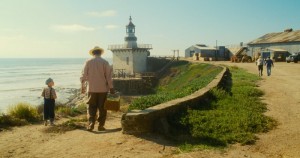
A scene from Little Boy – click to enlarge
Little Boy, with a $20 million budget, was written and directed by Alejandro Monteverde. He also wrote and directed Bella which won the People’s Choice Award at the Toronto Film Festival, and the American by Choice Award for its positive contribution to Latino art and culture in the United States.
Posted by Elena del Valle on March 26, 2015

Buddy Valastro, host of Bakery Boss – click to enlarge
Video, photo: Discovery Familia
Interested in capturing the attention of women between 18 and 49 years of age Discovery Familia will air 13 one hour episodes, dubbed into Spanish, of Bakery Boss Mondays at 10 p.m. E/P starting March 30, 2015. The series, new to Discovery Familia, stars Buddy Valastro (Cake Boss) as he visits bakeries on the verge of bankruptcy around the country. Scroll down to watch a short video promotional clip in Spanish.
The show, produced by High Noon Entertainment, first aired in English on TLC in the United States in December 2013. It was filmed mostly in New York. Some filming also took place in Miami, Philadelphia, and Houston.
The show features the story of Pastry Is Art, a Miami bakery owned by Jenny, a Peruvian immigrant. She opened the businesses with her sister to discover work and family are not always a good match. In another episode, the host visits with Kristi, owner of Kristi G’s Cupcakes & More in Dallas. A former business executive, Kristi quit her job to open her own bakery, but business hasn’t been going so well, and she has serious problems with her employees, all relatives. According to promotional materials, in the stories showcased, Valastro listens to the owner’s problems, observes their operations, and advises the families on the best way toward financial success.
Valastro, a fourth generation baker born into the business owned and operated by his parents, grew up in New Jersey in an old fashioned Italian family. With the help of his family, Buddy grew Carlo’s Bakery, expanding outside of Hoboken for the first time. In 2013, Buddy and his family opened three new bakeries in New Jersey. He also opened his first restaurant, Buddy V’s, in the Venetian Las Vegas.
Part of Discovery Communications, Discovery Familia is a Spanish language network dedicated to “Hispanic women and the things they that matter in their lives.” Daytime programming is dedicated to children aged two to six. In the evening, the channel offers programming for women, focusing on home décor, food, health, beauty and parenting.
Posted by Elena del Valle on October 28, 2014
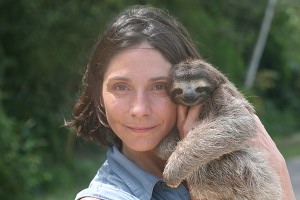
Ana Salceda poses with a sloth rescued from a hazardous road crossing in Panama
Photos: Thirteen Productions LLC
In these times of extensive development many are forced to leave their placid homes to make way for malls, residential complexes and commercial projects. Such is the case for sloths in parts of Latin America. In Panama, for example, the expansion of the Panama Canal has forced wild animals out of their habitats.
Among those affected are sloths. On November 5 between 8 p.m. and 9 p.m., Nature, a PBS series, will air for the first time A Sloth Named Velcro, a 50-minute documentary about sloths filmed in Panama, Costa Rica and Colombia. An editorial video clip without a hold harmless clause was not available for this article.
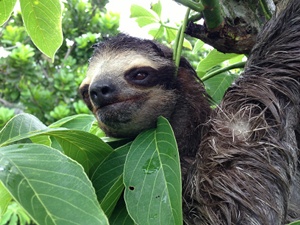
An adult sloth high in the canopy in Panama
The film is centered around Ana Salceda, a Washington D.C. area-based Spanish print and television journalist, as she returned to Central and South America to document sloth conservation efforts. Years earlier, while on assignment in Panama, she adopted a baby two-toed sloth she named Velcro. Her relationship with Velcro sparked an interest in sloths that remains alive today.
“I hope viewers see beyond sloths’ cute Mona Lisa smiles, and realize how fascinating, complex, and vulnerable they are. I hope they’re inspired by people like Tinka Plese, who is featured in the film and whose Aiunau Foundation rehabilitates displaced sloths and returns them to the wild,” she said about the documentary in promotional materials provided by the network. “And I hope my relationship with Velcro shows people how nourishing the human-animal connection can be, how it brings us closer to nature, and to ourselves.”

A mother sloth surrounds her young offspring in Panama
For many years, sloths were believed to be lazy animals who slept for most of their existence. Lately, they have become a hot topic among scientific researchers and black market pets. The film points to new studies that show the gentle creatures are not so sloth-like. To demonstrate their point Ana joins Bryson Voirin and his colleagues from the Max Planck Institute as they carry out a landmark study in the field about the sleep habits of sloths. Voirin discovered that, as opposed to their captive relatives, wild sloths sleep only about as much as humans. According to other studies, sloths are not as solitary as scientists used to think, they have social structures, and males keep harems. Surprisingly, recent research indicates sloths move like primates, only upside-down. The documentary features two-toed, three-toed and pygmy sloths.
A Sloth Named Velcro was produced by BelugaSmile Productions and Thirteen Productions LLC. Nature is a production of Thirteen Productions LLC for WNET. While PBS declined to provide budget numbers for the project, some of the funding sources were: Arnhold Family in memory of Clarisse Arnhold, Sue and Edgar Wachenheim III, Estate of Elizabeth A. Vernon, Lillian Goldman Charitable Trust, Kate W. Cassidy Foundation, Filomen M. D’Agostino Foundation, Susan Malloy and Sun Hill Foundation, Corporation for Public Broadcasting and public television stations.
Posted by Elena del Valle on May 20, 2014

B-boy in the air
Video, photos: Nadus Films
Inspired by concerns about guns, gangs and the uncertainty of a few b-boys survival in the ghettos they live in, and armed with the desire is “to impact the communities that helped make our films possible, while also impacting culture globally,” in mid 2010 Coury Deeb, founder and director, Nadus Films, and a small film crew went to Guatemala City, Guatemala. They spent 25 days filming Bboy for Life, a 78-minute documentary about break dancing youth in the city. The film was released last week. Scroll down to watch a video clip in Spanish with English subtitles.
Filmed in Spanish with English subtitles the documentary focuses on the lives of a handful of youth and their loved ones, on the one hand, and incarcerated gang members on the other.
The filmmaker set out to showcase a story of struggle, loss, hope and victory. Featured are Cheez and Gato, described as two of the best b-boys in Central America. They and their teammates, known collectively as Poker Crew, battle in the streets and on stage to compete against other dancers to be the best b-boys in the region.
According to the promotional materials, because of the gang violence being a b-boy or b-girl in Guatemala City is risky. Gato’s brother was shot and killed by a gang for not giving the names of other b-boys in his neighborhood, including Gato’s. Also interviewed in the film is Leidy, an active gang member and mother of two, who had only been out of prison for three days. Leidy spent over three years in prison for extortion.

Coury Deeb, director, Bboys for Life
“Ultimately, it’s a film about break-dancers, however, gangs are addressed in this film because it’s reality for anyone who struggles in the ghettos of Guatemala City,” said Deeb by email about the film which required 18 months of post production work and a $200,000 budget.
In response to a question about danger, he said: “We were careful, but at the same time, we’re story-tellers. We don’t sleep in the suburbs, instead, we buy crappy mattresses and sleep on the floor of a Guatemalans home in the ghetto. That’s where the story is. This is where the adventure is. The results are finding yourself in a small alley with stoned gangsters with guns and asking them why they murder people. Or, sitting w/ serial killers in maximum security prisons and asking them why they tortured people. Danger is unavoidable for those who properly tackle social justice issues inside documentary film-making.”
The film has attracted domestic and international distribution including attention as far as China. Funding was made possible by Blue Sky network, Aspiration Media, New World Distribution and a few smaller tiered associate producers.
“It’s a powerful story, that encompasses some of the most entertaining elements to film making. Hip hop is global. There are b-boys and b-girls in every country. Regardless if you’re in the ghetto or the suburbs, the story is highly entertaining and energetic, so it’s garnered the attention and support from every walk of life,” said Deeb, a filmmaker, storyteller, thrill-seeker, philanthropist, entrepreneur, husband and father of three. “Before the films release, we were able to get Leidy (central character) a year long scholarship. We also provided a scholarship for a few more b-boys in the Poker Crew.”
The opening markets are New York, Los Angeles, San Antonio, and El Paso. Wide distribution is expected including the following channels: iTunes, Amazon (DVDs for purchase), Walmart (DVDS), Google Play, YouTube Movie Rentals, Playstation, Hulu, X-Box, SnagFilms, Roku, MGO, Vimeo as well as Video On Demand: Comcast, Time Warner, Cox and Starz.
The film received Audience Choice Award at Cate Santa Barbara Film Festival, Official Selection at A3C Hip Hop Film Festival, Best Documentary Direction at Cincinnati Film Festival, Official Selection at Bronzeville Film Festival and NYC Independent Film Festival Honorable Mention.
Posted by Elena del Valle on March 6, 2014
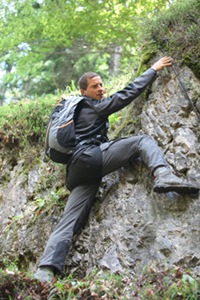
Bear Grylls
Video, photos: Discovery en Español
Targeting an adult audience between 25 and 49 years of age Discovery en Español will release the six-part series Bear Grylls: Escape from Hell (Escape del Infierno con Bear Grylls) as part of a new programming block dedicated to human adventure and survival shows Thursday nights. The programs will be dubbed into Spanish from the original English language production. The first 60-minute segment will air at 9 p.m. ET/PT March 6, 2014 and the final episode will air April 9 of the same year. Scroll down to watch a promotional video in Spanish.
According to a press release, Escape del Infierno con Bear Grylls reveals true stories and first person accounts of people who escaped death in some of the most desolate and hostile places on the planet. Each episode presents three real life incidents in places such as the heart of the Amazon Jungle or California’s Sierra Nevada. Grylls traces back the steps taken by survivors, analyzing their life-saving techniques, mistakes made, and the ways they could have adverted danger.

A scene from Vivir para Contarlo
Some of the stories described in the program include: Eric Le Marque, who endured eight days in below zero temperatures in California’s Sierra Nevada. Even after falling in the freezing waters of a river, he kept walking until he was rescued; the French explorers Loic Pillois y Guilhem Nayral, who each lost more than 45 pounds after roaming the heart of Amazon for seven weeks; Polish natives Maciej Tarasin end Tomek Jedrys, who became lost in the Raudal del Tiburon Canyon in Colombia; Italy’s Mauro Prosperi, a contestant in a race in the Sahara Desert who went astray and had to face the highest temperatures on the planet for nine days without water.
The Bear Grylls series, produced by betty (an English production house owned by Discovery Communications Inc.) for Discovery Networks International in English, was completed and aired in the United States and abroad in 2013. Sarah T Davies is executive producer for Discovery Networks International. Neil Smith is the executive producer for betty.
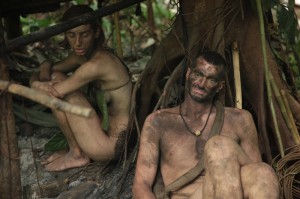
A scene from Supervivencia – click to enlarge
Other survival shows to be featured as part of the Thursday night block include a new season of Vivir para Contarlo Thursdays at 8 p.m. ET/PT. The original series highlights stories from Latin America. A weekly program Supervivencia al Desnudo will air Thursdays at 10 p.m.ET/PT. It will showcases a new pair of total strangers, one man and one woman, stranded in and exposed to some of the world’s most extreme weather environments in a remote location, for 21 days, without food, water, or clothing.
Posted by Elena del Valle on February 20, 2014
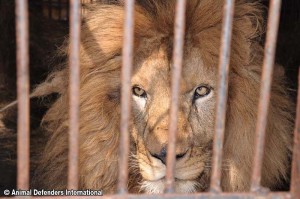
Hercules before Operation Lion Ark – click image to enlarge
Video, photos: Animal Defenders International (ADI)
Animal Defenders International (ADI), a 501(c)(3) nonprofit organization registered in Delaware and California, with offices in Los Angeles, London and Bogota, campaigns on behalf of animals used in entertainment, and other industries. Recently, the organization relocated circus animals, including 29 lions, from circuses in Bolivia after that country’s legislature passed a new law banning animals in traveling circuses, and asked ADI for assistance relocating the lions abroad.
According to ADI, Bolivia’s ban on animals in traveling circuses was the result of the organization’s undercover investigation that exposed behind the scenes cruelty, and its public education campaign. While one circus surrendered the lions voluntarily eight others weren’t ready to comply initially. ADI, with the support of government representatives, pressured the circuses into turning the remaining lions into their custody.
During Operation Lion Ark in 2011, in addition to the lion seizures, the team assisted in moving six monkeys, a coati mundi, a deer and a horse. The native wild animals (monkeys, coati mundi and deer) were returned to protected wild areas.
“What I didn’t realize was that it was going to be an extraordinary story about the human spirit and what the human spirit can do when people come together,” said Jorja Fox, an actress known for her role as Sara Sidle in television show CSI who was an associate producer of Lion Ark and also appears in the film, in a press release.
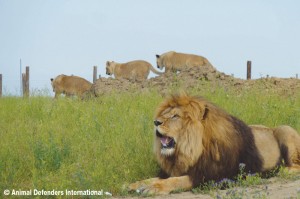
Hercules after Operation Lion Ark – click image to enlarge
There were about twenty people in the ADI team that saw to the rescue and relocation of the circus animals. They were from Britain, Bolivia, Colombia, Peru and the United States. The organization filmed the activities that took place during the seven month period in which 25 of the 29 lions were seized from the circuses, rehabilitated, flown to their new home in Colorado and released in their new habitat. The result was Lion Ark, a moving film that covers the process from the ADI perspective and features interviews with investigators, campaigners, government officials and members of congress in Bolivia.
The film was separate from the relocation project and took about two and half years to complete. Scroll down to watch short video clip of Lion Ark film.
The relocation of the animals, ground and air transport, crates and the building of the animal enclosures and lion houses at sanctuaries the United States cost over a million dollars. The film budget itself was separately funded, and was about half a million dollars. Bob Barker, a well known celebrity in the United States and an animal rights advocate, funded Operation Lion Ark.
In order to provide the lion prides an experience as close as possible to what they might have had in a natural environment, they were placed in four natural enclosures (among the largest available) occupying 80 acres at The Wild Animal Sanctuary (TWAS) near Denver, Colorado.
“People sometimes ask, why bother about animals when there’s so much human suffering? But it is not a choice of one or the other. When we protect the weakest or the most vulnerable, whether it is animals or people, we all gain. That’s how we shape our world…understanding our connection with other species, and our place on this planet, is the next step in human evolution,” said Jan Creamer, president and founder, Animal Defenders International, in the film.
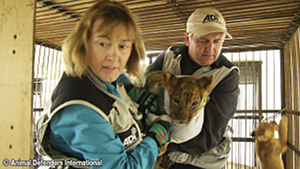
Jan Creamer and Tim Phillips of ADI and a lion cub
Since their relocation, the Lion Ark lions have been living in family prides at the Colorado facility where ADI plans to continue to fund their care for the rest of their lives, according to ADI. The new lion home was outfitted with fencing and basic safety measures as well as enrichment facilities, wooden constructions to climb and play on, hill-like mounds and underground dens, to provide a diverse and exciting space to keep the lions busy and stimulated.
Lion Ark, the film, was nominated for this year’s Image Awards of the National Association for the Advancement of Colored People (NAACP) in the Outstanding International Motion Picture category. The other five nominees in the that category are: War Witch; Call Me Kuchu; La Playa D.C.; and High Tech, Low Life.
Lion Ark Film Festival Selections include: Winner Best Documentary (Jury Award), Sun & Sand Film & Music Festival, Mississippi; Winner Audience Choice Best Documentary, San Diego Film Festival; Audience Choice Award Anchorage International Film Festival; Official Selection Raindance Film Festival, London; Official Selection Mill Valley Film Festival; Official Selection Hawaii International Film Festival; Official Selection Fort Lauderdale International Film Festival; Official Selection Virginia Film Festival; Official Selection Starz Denver Film Festival; Official Selection Irvine International Film Festival; Official Selection Beloit International Film Festival; Official Selection Sedona International Film Festival.
“We are honored to have been nominated for this award. Lion Ark is a film about respect for people and animals so we are really pleased to receive this acknowledgement,” said Tim Phillips, director, Lion Ark, in a press release. “In this film, you see the worst of humanity, but also humanity at its best. It is an empowering film that shows that people can make a difference. Lion Ark shows how animal protection is a vital part of the fabric of social justice, where human society draws a line as to what is, and is not, acceptable.”
The producers of Lion Ark hope to have the movie on general release in 2014. Once Lion Ark is purchased by movie distributors, it should become available at movie theaters, and via TV, DVD and VOD, a representative explained by email. As of November 10, 2013, Lion Ark had appeared in eight major film festivals in United States and United Kingdom.
http://www.ad-international.org/adi_usa/ (required by Animal Defenders International)
Posted by Elena del Valle on November 21, 2013
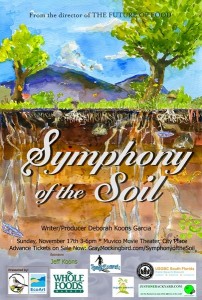
Symphony of the Soil movie poster – click to enlarge
Video, photos: Lily Films
It took filmmaker Deborah Koons Garcia four years and much work to complete Symphony of the Soil, a 104-minute documentary film about the complexity and mystery of soil. Filmed on four continents and featuring the insights of dozens of experts including some of the world’s most esteemed soil scientists, farmers and activists, the insightful film portrays soil as an essential element for our survival. Scroll down to the watch film trailer.
Relying on striking cinematography by John Chater, and Nancy Schiesari in the United Kingdom, combined with art and animation the director illustrates the pivotal role of soil in our world. Experts on screen expound the importance of good soil in solving some of the planet’s most vexing environmental and healthy food supply problems.
The first third of the documentary focuses on soil science. How soil is formed and its life cycle as well as the physical components of soil, the soil orders, the microorganisms that cycle nutrients, soil and plants, and the interrelationship of the many members of the soil community, including humans.
The second third of the film focuses on the relationship between people and soil, especially human’s use of soil for agriculture. The third section explores soil and climate change, water use, health and other topics that support the case for treating soil with care such as the return to small scale organic farming as a viable solution to the problems of resource depletion, climate change and the end of oil; and to the importance of seeds and seed saving in India.
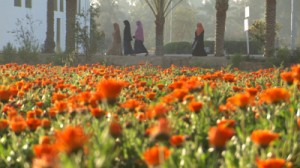
Sekem calendula field
Symphony of the Soil is the second major production of Lily Films. In it the film producers strive to raise consciousness about how people think and treat soil, seeking that they realize that destructive land use practices degrade and poison the soil and that society should take responsibility for protecting and improving soil for the generations to come.
It was filmed on four continents, in six countries, the United States, England, Wales, India, Egypt, and Norway. Some of the locations include, in the United States, Oregon, Washington, California, New York, West Virginia, Kansas, Iowa, Vermont, Hawaii; in the United Kingdom, Devon, Hastings, Bristol, Wales, and Ceredigion; in India, Punjab, Uttarakhand, Rajasthan; in Egypt, Cairo and Aswan; and in Norway, Tromso.
The film was Winner of the Life Sciences Film Festival, Prague 2012, Merit Award for Scientific Information from the Montana CINE International Film Festival, September 2012, and Winner of the 2013 Cinema Verde Film Festival’s Food Award. Koons Garcia received the John de Graaf Environmental Filmmaking Award for her body of films on agriculture, genetically modified food and sustainability at the Wild and Scenic Film Festival, January 2013.
Koons Garcia, a bay area filmmaker, has made fiction, educational and documentary films. For the last ten years, she has focused on films about agriculture, the food system and environmental issues. Lily Films, her film production company based in Mill Valley, California, funded the lion’s share of the production costs for the documentary.
Posted by Elena del Valle on September 20, 2013
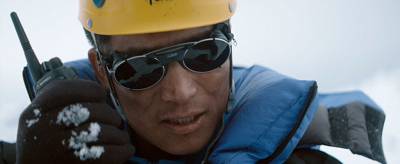
Pemba talks to sherpas on the radio
Photos, video: Robbie Ryan, IFC Films
On August 1, 2008, eleven mountaineers from international expeditions died on K2, said to be the second highest mountain in the world. Three others were seriously injured. It was the worst single accident in the history of K2 mountaineering. Following that day, many wondered why the athletes risked serious injury or death to reach a place inhospitable to humans. Questions about the events and decisions that led to the accident lingered. Unsung heroes were brought to light by some of the survivors.
The Summit, a 99-minute film, rated R and produced in 2012, explores the complex questions that arose that day. It was filmed on location in Ireland, Switzerland, Pakistan, Spain, Serbia, Nepal, Italy, Holland, Norway and Sweden. It features, according to promotional materials and a trailer (no review copy was made available), reenactments based on the testimony of the survivors. It is scheduled to open October 4, 2013 at the Lincoln Plaza, 1886 Broadway, and Sunshine, 143 E Houston Street, in New York City. The following week the film is slated to open at theaters nationwide. Scroll down to watch a film trailer.
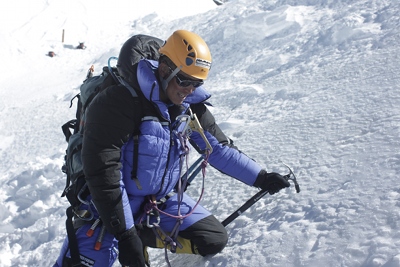
A scene from The Summit
Although the climbing season at K2 usually runs from June to August, in 2008 poor weather made the mountain inaccessible. By the end of July, ten groups of climbers were waiting for an opportunity to scale the summit. Some of the people had waited for almost two months before attempting to reach the top of the mountain. Many lost their lives in the attempt.
The film is Winner of the 2013 Sundance Film Festival Editing Award and 2013 Sundance Film Festival Grand Jury Prize Nominee. It was produced and directed by Nick Ryan, written by Mark Monroe and edited by Ben Stark with the support of investment incentives for the Irish Film Industry from the Government of Ireland.

































